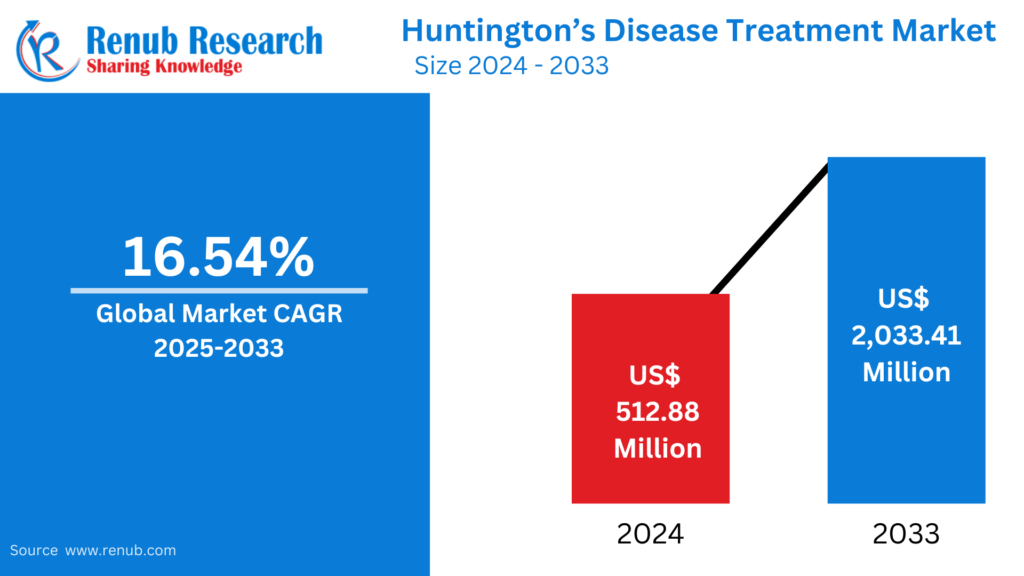Huntington’s Disease Treatment Market Size and Share Analysis – Growth Trends & Forecast Report 2025–2033
Renub Research | Healthcare – Diagnostics Segment
Executive Summary
The Huntington’s Disease Treatment Market is poised for significant growth, projected to reach US$ 2,033.41 million by 2033 from US$ 512.88 million in 2024, expanding at a CAGR of 16.54% from 2025 to 2033. This growth is driven by increased diagnosis rates, rising awareness, and the emergence of novel therapeutic approaches, including gene therapies and RNA-based treatments.
Table of Contents
- Market Overview
- Disease Background and Prevalence
- Market Drivers
- Market Challenges
- Regional Market Insights
- Market Segmentation
- Competitive Landscape
- Strategic Insights
- Key Questions Answered
- Conclusion
- Market Overview
Huntington’s disease (HD) is a progressive, fatal, inherited neurological disorder that affects motor function, cognition, and behavior. Current treatments are symptomatic and lack disease-modifying potential, but ongoing research into genetic therapies shows promise for transformative breakthroughs.
Key Highlights:
- Growing R&D investment is propelling therapeutic development.
- Surge in demand for personalized and targeted therapies.
- Early diagnosis and better biomarkers are reshaping the treatment landscape.
- Disease Background and Prevalence
HD is caused by an abnormal CAG trinucleotide repeat expansion in the HTT gene. It affects around 5.7 per 100,000 in North America and up to 10 per 100,000 in Europe. Juvenile HD cases make up 5–10% of all diagnoses.
Global Prevalence Insights:
- USA: 1 in every 10,000 people
- Europe: Higher incidence than Asia
- Asia-Pacific: Underreported due to diagnostic disparities
- Market Drivers
3.1 Rising Awareness and Early Diagnosis
Increased awareness campaigns and genetic counseling are leading to earlier and more accurate diagnoses. Early intervention improves the efficacy of treatments and boosts the demand for therapies.
3.2 Technological Advancements in Drug Development
Technologies such as CRISPR, RNA interference (RNAi), and antisense oligonucleotides (ASOs) are paving the way for disease-modifying solutions. Adaptive clinical trials and biomarker-based designs are fast-tracking R&D.
3.3 Increased Research Funding and Collaborations
Government bodies, patient advocacy groups, and biopharma companies are significantly investing in HD research. Collaboration models are accelerating innovation.
New Publish Reports
- Inflammatory Bowel Disease Treatment Market Size and Share Analysis – Growth Trends and Forecast Report 2025-2033
- Global Human Microbiome Market Report by Application (Therapeutics, Diagnostics) Disease (Obesity, Diabetes, Autoimmune Disorders, Cancer, Gastrointestinal Disorders, Central Nervous System Disorders, Other Diseases) Product (Probiotics, Prebiotics, Symboitics, Other Products), Countries and Company Analysis, 2024-2032
- Cancer Pain Management Market Report by Treatment (Immunotherapy, Radiotherapy, Chemotherapy, Hormone Therapy, Targeted Therapies, Inhibitors, Surgery, Others), Drug Type (Opioids, Non-Opioids, Nerve Blockers), Disease Indication (Lung Cancer, Colorectal Cancer, Breast Cancer, Prostate Cancer, Blood Cancer, Others), Country and Company Analysis 2023-2030
- Market Challenges
4.1 Lack of Disease-Modifying Therapies
Existing treatments only manage symptoms. Developing drugs that can reverse or halt disease progression remains complex due to the genetic intricacies of HD.
4.2 Small Patient Population
With a relatively low global prevalence, HD presents commercialization challenges. High R&D costs, limited trial recruitment, and reimbursement hurdles limit widespread drug development.
- Regional Market Insights
5.1 United States
Strong pipeline and advanced research infrastructure. The presence of key players and ongoing trials in gene therapy make the U.S. the global leader.
5.2 Germany
Growing R&D and government-backed initiatives. Germany’s advanced healthcare infrastructure and early diagnosis programs contribute to steady market growth.
5.3 China
HD awareness is rising. Government investment in rare disease research and improved diagnostic capabilities are enhancing market potential despite low incidence.
5.4 Saudi Arabia
Still in nascent stages. Growing awareness and healthcare investments present long-term potential. Regulatory reforms and collaborations with global players are key.
- Market Segmentation
By Drug Type:
- Approved Drugs (e.g., Tetrabenazine, Deutetrabenazine)
- Off-label Drugs (e.g., Antidepressants, Antipsychotics)
By End User:
- Hospital Pharmacy
- Drug Store & Retail Pharmacy
- Online Pharmacy
By Region (Sample):
- United States
- Germany
- China
- Saudi Arabia
- Canada, Japan, UK, France, India, UAE, and more (Total 21+ countries covered)
- Competitive Landscape
Key Players Profiled:
- H. Lundbeck
- Pfizer Inc.
- Bausch Health Cos
- Teva Pharmaceutical Industries
- Dr. Reddy’s Laboratories
- Sun Pharmaceutical Industries
- Hikma Pharmaceuticals Plc
Competitive Analysis:
- Company Overview
- Key Executives
- Recent Developments
- Financial Performance
- Strategic Insights
- M&A Activity: Strategic acquisitions and licensing agreements to gain pipeline access.
- R&D Focus: Innovation in genetic therapies and biomarkers.
- Global Expansion: Companies are focusing on emerging markets to expand patient access.
- Key Questions Answered
- What is the projected size of the Huntington’s Disease Treatment Market by 2033?
- Which are the most promising drug development technologies in the HD pipeline?
- How does the market differ across regions like the U.S., Germany, China, and Saudi Arabia?
- What are the major challenges faced by drug manufacturers in this market?
- Which companies are leading innovation in HD treatment?
- What is the impact of early diagnosis and genetic counseling on market growth?
- How is the regulatory environment evolving for HD therapies globally?
- What role do online pharmacies play in HD treatment distribution?
- How does patient advocacy influence treatment development?
- What are the investment trends and partnerships shaping the HD therapy landscape?
- Conclusion
The Huntington’s Disease Treatment Market is evolving rapidly with a promising outlook. Innovations in gene therapy, RNA-based solutions, and personalized medicine could redefine the future of HD care. However, success hinges on overcoming barriers such as limited prevalence, high treatment costs, and complex regulatory processes. With increased awareness, global collaborations, and patient-centric innovations, the market holds the potential to drastically improve quality of life for HD patients worldwide.

